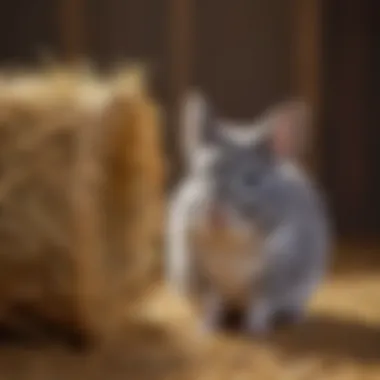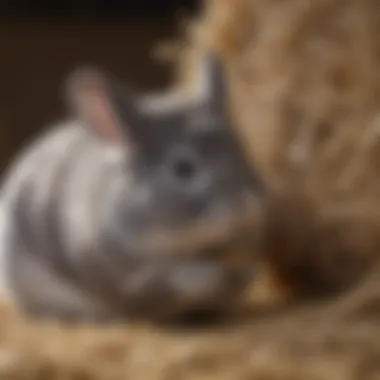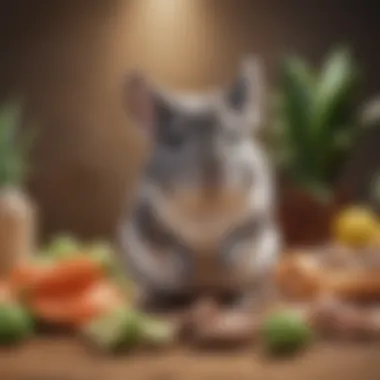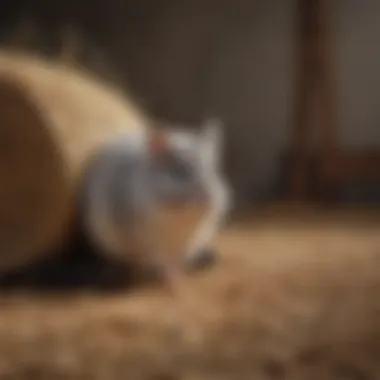Choosing the Best Hay Feeder for Chinchillas


Intro
Selecting the proper hay feeder for chinchillas is more than just a matter of convenience; it plays a crucial role in their overall health and well-being. This guide aims to illuminate the various aspects to consider when choosing a suitable hay feeder. By understanding the unique needs of chinchillas, pet owners can ensure that they provide the right feeding environment. This can prevent issues like obesity or dental problems which are prominent in this species.
In the following sections, we will explore the physical characteristics, diet, and social behaviors of chinchillas. This will provide context for the feeder requirements. We will also touch on the types of hay feeders available, their materials, and practical tips for making an informed choice related to the hay feeder. Moreover, this guide will highlight the importance of these accessories in maintaining a healthy habitat for chinchillas.
Read on to ensure your chinchilla thrives with the best hay feeder designed to meet its dietary needs.
Understanding Chinchilla Dietary Needs
Understanding the dietary needs of chinchillas is crucial for their overall health and well-being. As herbivores, these animals require specific nutrients to thrive. Providing them with appropriate food is not just about filling a bowl; it is an essential aspect of their care. An informed approach to their diet helps prevent health issues and enhances their quality of life.
Nutritional Requirements
Chinchillas have distinct nutritional requirements that differ from those of other pets. Their diet primarily consists of fiber, which is necessary for their digestive health. A high-fiber diet promotes dental health as well, enabling them to naturally wear down their constantly growing teeth. Chinchillas need a balance of proteins, carbohydrates, vitamins, and minerals as well. A typical recommendation is around 15-20% crude fiber, around 16-20% protein, and low fat content.
Role of Hay in Diet
Hay plays a pivotal role in the diet of chinchillas. It provides the essential fiber required for proper digestion. Without sufficient hay, chinchillas could suffer from gastrointestinal issues. Hay also aids in dental health, as chewing it helps wear down teeth. Moreover, chinchillas enjoy the texture and taste of hay, making it a favorite food choice.
"Feeding hay regularly is not just beneficial; it is essential for chinchilla health."
Common Hay Types Suitable for Chinchillas
Selecting the right hay is important. Not all hay types are suitable for chinchillas. The most common options include:
- Timothy Hay: This is one of the most popular choices. It is well-balanced regarding fiber and protein and is widely available.
- Orchard Grass Hay: This type is softer than Timothy and may appeal to chinchillas that prefer a softer texture.
- Meadow Hay: Contains a variety of grasses and plants, offering a diverse nutrient profile.
- Alfalfa Hay: High in protein and calcium, it should be offered sparingly, especially to adults. It is more suitable for young or lactating chinchillas.
Choosing the right hay is key for chinchilla owners. It promotes health and vitality.
Importance of a Suitable Hay Feeder
The choice of a hay feeder is essential for chinchilla wellbeing. It is not just about providing food; a proper hay feeder can influence the overall health and behavior of these small animals. A suitable feeder should meet specific dietary needs while also addressing behavioral aspects. Chinchillas are naturally curious creatures, and the way hay is presented can impact their feeding habits and enjoyment of food.
Enhancing Accessibility
Accessibility is the key when it comes to feeding chinchillas. They need to reach their hay easily to encourage foraging behaviors. A feeder that is too high or complicated can prevent them from accessing food, leading to frustration. Choosing the right feeder can significantly enhance accessibility.
For example:
- Hanging feeders can be positioned at different heights to accommodate chinchillas at various ages.
- Gravity-fed feeders allow hay to drop down when it is consumed, reducing the need for constant refilling.
- Open racks make it easy for chinchillas to pull out what they need while allowing them to enjoy hay naturally.
Minimizing Waste
Waste management is another crucial element when selecting a hay feeder. Chinchillas can be messy eaters. They might scatter excess hay if it is not contained properly. A good feeder design minimizes waste, ensuring that chinchillas consume as much hay as possible.
Here are a few strategies to minimize waste:
- Design: Use feeders that have smaller openings to prevent spilling.
- Container types: Gravity-fed systems often ensure that only what is needed falls to the bottom, reducing loose hay.
- Materials: Choosing a robust material can prevent breakage and loss of hay.
Encouraging Healthy Eating Habits
Healthy eating habits in chinchillas can be encouraged through proper feeder choice. When chinchillas have access to fresh hay in a comfortable setting, they are more likely to munch away happily. This can lead to better dental health and digestive function.
To promote good habits, consider the following:
- Consistency: Regularly refill the feeder with fresh hay to create a routine.
- Variety: Offer different types of hay to keep their interest piqued and nutritional value high.
- Cleanliness: Ensure the feeder is cleaned regularly to promote a hygienic eating area, preventing illness.


A well-designed hay feeder serves as both a feeding station and a toy, enhancing chinchilla's mental engagement.
Types of Hay Feeders for Chinchillas
Selecting the right hay feeder is crucial for any chinchilla owner. Different feeder types offer distinct advantages and disadvantages. Understanding these options enhances the overall well-being of chinchillas and facilitates healthy eating habits. A well-chosen hay feeder not only optimizes hay accessibility but also aids in minimizing waste. This section outlines various types of hay feeders, their benefits, and practical considerations for chinchilla care.
Hanging Hay Feeders
Hanging hay feeders are popular among chinchilla enthusiasts. They suspend from the cage ceiling and provide a convenient and stimulating way for chinchillas to access hay. This type prevents the hay from being soiled, keeping it fresh and clean. The design may vary from simple mesh bags to more complex cages that secure the hay tightly. This ensures chinchillas pull out bits without tripping over or wasting their food.
"The height of the feeder can encourage your chinchilla’s natural instincts to jump and climb, promoting physical activity."
However, one must consider the ease of refilling. Some hanging designs can be cumbersome if not made properly. It is advisable to choose a feeder that is easy to open and refill, ensuring the chinchilla’s diet remains consistent without extended periods of food shortages.
Gravity-fed Hay Feeders
Gravity-fed hay feeders are centered around a simple yet effective design. They allow hay to flow downwards through a mechanism, ensuring constant availability without the mess of scattered hay. This design minimizes the need for active refilling, making it convenient for owners with a busy schedule.
The benefit of using a gravity-fed option is also the added stability. These feeders often have a wider base, reducing the risk of tipping over. When selecting one, ensure it is designed specifically for chinchillas, as some models may cater to other small animals, which may not be suitable for chinchillas’ feeding habits.
Hay Balls and Hay Racks
Hay balls and racks offer an interactive way for chinchillas to engage with their food. Hay balls are often made from safe materials and allow for a playful, foraging experience. Chinchillas will enjoy rolling the balls to access the hay inside. On the other hand, hay racks allow for the display of hay more prominently. They keep the hay elevated, reducing chances of contamination.
These options require monitoring. As chinchillas eat, these feeders can become messy, needing regular cleaning to maintain hygiene. Therefore, owners should integrate these types into a cleaning schedule to maintain a healthy environment.
DIY Options for Hay Feeders
Some pet owners may prefer creating their own hay feeders. DIY options can range from simple cardboard boxes to more intricate designs using wood or metal. This option allows for customization according to specific cage dimensions and chinchilla preferences.
It is important to select non-toxic materials. Simple construction can lead to massive savings, but they should also prioritize chinchilla safety. Instructions for various DIY designs can easily be found online, allowing owners to build something functional and unique. However, always ensure the final product does not present any dangers, such as sharp edges or small parts that can be ingested.
Material Considerations
Selecting the right materials for a chinchilla hay feeder is fundamental for ensuring the health and safety of these sensitive animals. The materials used can affect the animal's well-being, the feeder's lifespan, and overall functionality. It is essential to consider factors such as non-toxicity, safety, durability, and longevity when choosing a feeder. Understanding why these aspects matter will guide pet owners in making an educated decision.
Non-toxic and Safe Materials
When choosing a hay feeder, ensure that it is made from non-toxic and safe materials. Chinchillas tend to chew on their feeders, making it imperative that the materials used are free from harmful substances. Wood, metal, and certain types of plastic may varying levels of safety based on their composition.
Key considerations include:
- Wood: Opt for untreated wood, as chemically treated varieties may contain harmful preservatives. Safe options include maple or birch, which are less likely to pose health risks.
- Metal: Stainless steel is a preferred choice because it is sturdy and easy to clean. Ensure it is free from sharp edges that could injure your chinchilla.
- Plastic: If using plastic, choose BPA-free, non-toxic types that can withstand chewing without releasing harmful chemicals.
Always verify product information and manufacturing details to confirm safety standards.
Durability and Longevity
Durability and longevity are critical factors when selecting a hay feeder for chinchillas. Since chinchillas are known for their chewing habits, a feeder must withstand wear and tear over time without compromising safety or function. A well-constructed feeder not only serves its purpose but can also prevent unnecessary replacements.
Important aspects to consider include:
- Material resistance: Evaluate how well the materials resist chewing and scratching. Durable feeders made from quality materials will last longer, saving owners money in the long run.
- Design factors: Look for feeders that integrate sturdy construction designed to handle the chinchilla's active behaviors. Feeders that are stable and less likely to tip over will reduce mess and waste.
- Maintenance ease: A feeder that can be easily cleaned and maintained will have a longer lifespan. Optimal materials should not degrade or warp when exposed to moisture or cleaning solutions.
Evaluating Size and Design
Evaluating the size and design of hay feeders is crucial for the well-being of chinchillas. These small animals require feeding accessories that are appropriately scaled to their size. The proper feeder allows them to access hay easily and comfortably while promoting healthy eating habits. A suitable design considers not only the aesthetic aspect but also the functionality and safety of the feeding solution.


Proportions for Different Chinchilla Sizes
Chinchillas vary in size, with some being significantly larger than others. Therefore, selecting a hay feeder that accommodates different chinchilla sizes is important. A feeder that is too small may not hold adequate hay, requiring frequent refills. Conversely, a feeder that is too large might pose accessibility challenges for smaller chinchillas. In general, the feeder should allow for sufficient space to access hay without hindrance. It's advisable to measure the chinchilla and assess its growth to ensure ongoing suitability of the feeder as it matures.
- Miniature Chinchillas: Look for feeders with compact designs that offer easy reach without excessive stretching.
- Standard-sized Chinchillas: Most feeders designed for small to medium pets work well, allowing for easy access while maintaining a stable structure.
- Larger Chinchillas: Select feeders that provide ample room and can hold larger quantities of hay, ensuring that the chinchilla can eat comfortably.
Feeder Configuration and Accessibility
Feeder configuration plays a major role in how easily a chinchilla can access hay. An optimal design will enhance the feeding experience, reducing frustration and encouraging proper eating habits. The feeder should be positioned in a way that allows the chinchilla to reach the hay without unnecessary effort. Considerations for configuration include:
- Height: The feeder should be at a height that is comfortable for the chinchilla to reach, whether it’s on the ground or elevated.
- Entry Points: Multiple openings can facilitate easier access to the hay, especially if sharing between multiple chinchillas.
- Secure Structure: Ensure the feeder is stable and will not tip over when the chinchilla climbs around, as chinchillas are known for their playful nature.
A thoughtful configuration enhances not just accessibility but also encourages the chinchilla to explore and engage with its environment, fostering a more enriching habitat. In summary, a proper evaluation of size and design, considering both proportions and configuration, contributes significantly to a chinchilla’s overall health and happiness.
Reviews of Top Hay Feeders Available
Selecting the right hay feeder can make a significant difference in the feeding habits and health of your chinchilla. These specially designed accessories allow pet owners to ensure that their pets receive the hay they need while minimizing waste and maximizing accessibility. Evaluating various models available on the market helps pet owners make informed decisions based on their specific requirements. In this section, we will delve into three popular brands, covering their key features, benefits, and potential drawbacks. This information is vital for ensuring that the chosen hay feeder supports a chinchilla's dietary needs effectively.
Brand A: Overview and Pros/Cons
Brand A has positioned itself as a reliable choice among chinchilla owners. Their hay feeder emphasizes ease of use and functionality. Constructed from safe materials, this feeder is designed to hold a generous amount of hay, ensuring that your pet has access at any time.
Pros:
- Durability: Made from sturdy materials that resist chewing.
- Capacity: It can hold a larger amount of hay than standard feeders, reducing the frequency of refills.
- Easy to Clean: Its simple design allows for quick disassembly, making cleaning less of a chore.
Cons:
- Initial Cost: Compared to basic models, this feeder is priced at a premium.
- Weight: Some users have noted that its heavier design makes it less mobile.
Brand B: Overview and Pros/Cons
Brand B focuses on innovative designs aimed at reducing hay wastage. Featuring a mesh design, this feeder allows for airflow, keeping the hay fresh. Its compact size is ideal for smaller enclosures, making it a preferred choice for many.
Pros:
- Wastage Reduction: The mesh design minimizes spillage and maximizes hay consumption.
- Compact: Suitable for small spaces, which is ideal for cage setups.
- Affordability: Priced competitively, it provides good value for money.
Cons:
- Limited Capacity: Smaller size means it requires more frequent refills.
- Material Concerns: Some users reported wear and tear over time, especially if chewed consistently.
Brand C: Overview and Pros/Cons
Brand C offers a versatile hay feeder that can be mounted or used freestanding. It prioritizes function and aesthetic appeal, designed to blend harmoniously with the pet environment. Its unique style makes it a favorite among many chinchilla owners.
Pros:
- Versatility: Can be used in multiple ways, allowing for customization based on user preference.
- Design Aesthetics: Known for its visual appeal, it suits various interior styles.
- High Capacity: This model can store a significant amount of hay, making it less cumbersome for daily use.
Cons:
- Installation Required: Some assembly is necessary before it can be used.
- Price Point: It may not be the best choice for those on a tight budget.
Selecting the right hay feeder goes beyond just functionality. It's about creating a healthier feeding environment for your chinchilla while also matching your living space aesthetic.
By comparing these brands, potential buyers can identify which features matter most for their chinchilla's well-being and fit within their feeding routines. Each of these options presents unique advantages and limitations, enhancing the understanding of which product might best suit individual needs.


Cost Considerations in Hay Feeders
Cost is a significant factor when selecting a hay feeder for your chinchilla. It is essential to balance budget constraints with the need for quality and efficiency. A suitable hay feeder should not only fit within your financial plan but also provide adequate functionality. Cost considerations extend beyond the initial purchase price. Think about durability, maintenance, and usability over time. A more expensive model might offer features that lead to less waste or improved access, which saves money in the long run.
Budget-friendly options often attract first-time chinchilla owners. They help minimize the initial financial outlay and can still offer reasonable functionality. However, these feeders may compromise on quality and longevity. Conversely, investing in more expensive models can lead to improved standards and features that contribute positively to your pet's health and well-being.
Budget-friendly Options
When seeking budget-friendly options for hay feeders, you can find several satisfactory solutions. Some feeders provide efficient storage and access while keeping costs low. Here are a few notable points about budget-friendly hay feeders:
- Affordability: Typically priced lower, these feeders can be more accessible for pet owners who are mindful of their budget.
- Simple Design: Many economical feeders have uncomplicated designs. This makes them easy to refill and clean.
- Basic Materials: Materials used may not always be the most durable. However, if maintained properly, they can last until you are ready to upgrade.
Examples of budget-friendly feeders include the Kaytee Hay and Treat Dispenser and the Chinchilla Hay Feeder by Living World. These options provide a balance between cost and functionality.
Expensive Models and Their Justifications
On the other hand, investing in higher-priced hay feeders can yield several benefits. The leading reasons for selecting an expensive model include:
- Durability: High-quality materials resist wear and tear, ensuring the feeder lasts for years.
- Enhanced Functionality: Features like adjustable compartments and anti-waste designs can significantly reduce hay spoilage, leading to savings over time.
- Health Benefits: Some premium feeders are designed to encourage natural feeding behaviors. This promotes better digestion and reduces stress in chinchillas.
- Aesthetic Appeal: More expensive models often come with an attractive design that complements your home environment.
For instance, the Trixie Natural Living Hay Feeder and the Ware Manufacturing Hay and Treat Rack are known for their premium build quality and thoughtful design. Investing in these models may lead to better welfare for your chinchilla, justifying the higher expenditure.
Ultimately, choosing the right hay feeder involves careful consideration of both initial and ongoing costs. Understanding the potential long-term benefits of more expensive options can be beneficial for informed decision-making.
Maintaining and Cleaning Hay Feeders
Maintaining and cleaning hay feeders is essential for the overall health of chinchillas. A clean feeding environment helps to prevent any potential health issues that can arise from unsanitary conditions. When hay feeders are not cleaned regularly, they can collect dust, mold, and even food residues that may be harmful to chinchillas. Additionally, cleanliness contributes to a more enjoyable feeding experience for the animal.
Regular maintenance ensures that the hay stays fresh and uncontaminated. It allows pet owners to monitor the amount of hay consumed and to assess their chinchilla's eating habits. Proper upkeep can also prolong the life of the feeder, making it a worthwhile investment for pet owners.
Regular Cleaning Routines
Developing a regular cleaning routine for hay feeders is critical. It is advisable to clean the feeder at least once a week. Here are some steps to follow for maintaining hygiene:
- Empty the Feeder: Start by removing any leftover hay or debris. This prevents any build-up of mold and bacteria.
- Wash with Mild Soap: Use a mild soap solution to scrub the feeder. Avoid harsh chemicals that may leave residues harmful to chinchillas.
- Rinse Thoroughly: After washing, rinse the feeder well to ensure that no soap remains. Soap residues can be toxic if ingested by chinchillas.
- Dry Completely: Allow the feeder to dry completely before refilling it with hay. Moist environments can promote mold growth.
- Inspect for Damage: While cleaning, check for any signs of wear or breakage. This helps in maintaining the feeder's integrity and safety.
Implementing these steps will keep the hay feeder clean and in good condition, supporting the health of the chinchilla.
Signs of Wear and Tear
Over time, even the best hay feeders can show signs of wear and tear. Recognizing these signs is key to preventing accidents or health issues for your chinchilla. Here are some common indicators to watch for:
- Frayed Edges: The material may begin to fray, which can pose a choking hazard. It is essential to replace any feeder showing visible damage.
- Cracks or Breaks: Plastic or wooden feeders can crack or break with use. Inspect the feeder often and replace it if you notice structural damage.
- Stains or Residue: Persistent stains or leftover residues can harbor bacteria. If cleaning does not resolve this, consider replacing the feeder.
- Odors: If the feeder emits a strong odor, it may indicate that it is harboring bacteria or mold, calling for immediate replacement.
Monitoring the condition of the hay feeder is vital. It allows owners to provide a safe and healthy feeding environment for their chinchillas.
Finale: Making the Right Choice
Choosing the right hay feeder for chinchillas is a vital decision that entails considering various factors. This article emphasizes the importance of selecting an appropriate feeding accessory that caters to the unique needs of chinchillas. Understanding their dietary requirements and the influence of hay on their well-being is crucial. The right feeder enhances accessibility, minimizes waste, and encourages healthy eating habits.
By summarizing the key elements covered in this guide, pet owners can make informed choices. Appropriate feeders not only improve the feeding experience for chinchillas but also contribute to their overall health. Understanding the various types of hay feeders, the materials used, and evaluating design aspects are essential steps for any chinchilla caretaker.
Recap of Key Considerations
When selecting a hay feeder, several key considerations arise:
- Dietary Needs: Ensure the feeder accommodates types of hay suitable for chinchillas.
- Feeding Habits: Adapt the feeder's design to encourage natural foraging behaviors.
- Material Safety: Prioritize non-toxic and durable materials to ensure safety and longevity.
- Size and Design: Choose a size that fits your chinchilla, ensuring ease of access.
- Maintenance: Consider how easy the feeder is to clean to maintain hygiene.
These aspects help determine the most suitable hay feeder for chinchillas, supporting their health and well-being.
Final Recommendations for Chinchilla Owners
- Assess Feeder Types: Analyze the pros and cons of each type of feeder such as hanging hay feeders, gravity-fed options, and DIY solutions.
- Consider Budget: Balance your budget with the features and durability of the feeder. Higher cost does not always guarantee better quality.
- Think Long-term: Invest in feeders designed for long-term use, ensuring they can withstand regular wear and tear.
- Monitor Chinchilla Behavior: Observe your chinchilla’s feeding habits after introducing a new feeder to ensure it meets their needs.
Making the right choice in a hay feeder is about creating an environment that supports chinchilla health and encourages natural behavior. Through informed decision-making, chinchilla owners can significantly impact their pets' quality of life.







